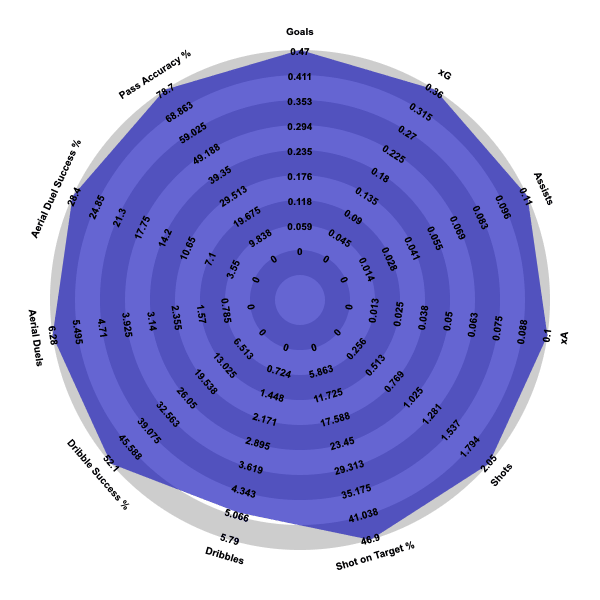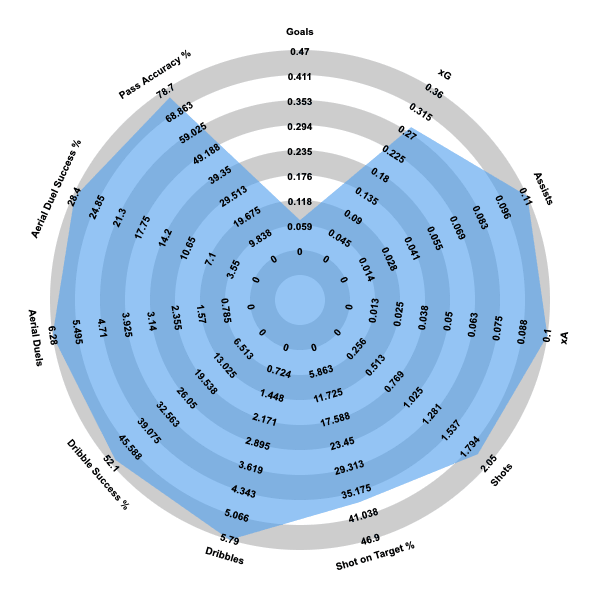Manchester City striker, Lukas Nmecha, has just signed for Vincent Kompany’s Anderlecht in the Belgian First Division A. Nmecha has been at Manchester City since he was nine years old. At 21 years old, the German player has recently utilised loan spells as a means of senior professional development and game time, after impressing for Manchester City at under-18 and under-23 level. Nmecha also earned praise throughout pre-season tours and a was given a handful of first-team appearances at Manchester City, all when he was just 18 years old.
Nmecha is clearly a talented player, given his longevity at Manchester City, his inclusion in first-team plans, albeit on a fringe basis, and the repeated development loans Nmecha is sent on. High-level EFL and Bundesliga clubs such as Preston North End, Wolfsburg, Middlesbrough and now Anderlecht in Belgium, have been keen to take the striker on. So far, his loan moves have allowed him to play senior football and learn his trade at the elite level, but, to date, his output has left many wanting more. At this stage in his career, Lukas Nmecha will be looking to really push on and establish himself as an effective striker at senior level in Europe, with the hope of a place in the Manchester City squad, or, a permanent transfer elsewhere. This data analysis will analyse Nmecha’s statistics, data analysis comparisons, his strengths and weaknesses.
High praise for the youngster
To provide a foundation for the analysis, top-level managers have praised Nmecha. Pep Guardiola stated the player has “great prospects”, Vincent Kompany said the forward “is a pure talent. He makes the right runs and gives us more options”. During his time at Manchester City, Kompany also described Nmecha as a “little brother” and the two were happy to play against each other in training, with Nmecha learning to adapt his game, rather than sticking to one style of play or being pigeonholed as a target man. Kompany now has three exciting young strikers to develop as individuals and within the modern system he wants to execute at Anderlecht.
Physical attributes and playing style
Originally, Nmecha was a winger, but the player was moved central after he grew to 6ft 1in and developed a strong athletic build. His physicality makes him strong, quick and provides him with the ability to hold the ball up, play as a target man or play on the shoulder of the last defender and make runs in behind. This relates to the previous point about being pigeonholed. Given his size and strength, Nmecha, could be stereotyped into being a target man or support striker, rather than a well-rounded attacker. But, Nmecha needs to learn when to play which role, when to bring others into play, when to run in beyond and when to carry the ball himself. This dilemma is a positive and negative, he has the attributes to play different styles depending on the situation or the tactical role needed, this leaves defenders unsure how to play against him. However, it puts pressure on Nmecha’s decision making and overall skill mastery, rather than allowing him to focus on one main strength and playing style. This may mean Nmecha’s development takes longer than players with a definitive style.
Nmecha’s numbers
Currently, Kompany has numerous young forwards that he will look to fit into his 4-3-3 system. Jérémy Doku at 18 years old, Landry Dimata at 22 years old, Antoine Collasin at 19 years old, Anouar Ait El Hadj at 18 years old and Nmecha himself at 21 years old. Typically, the centre forwards, who Nmecha is expected to be in direct competition with is Dimata and Colassin, with Doku and El Hadj typically being utilised on the wing. Percy Tau, who is 26 years old, has also featured on the wing. Dimata has been the favoured centre-forward during the start of the 2020/21 season and the majority of the 2019/20 season for Anderlecht.
Before we make comparisons between Anderlecht players, let’s take a look at Nmecha’s data in isolation, given his progression from youth to senior football and has experienced multiple loans in different leagues. Firstly, we will look at his youth career.
| Youth Career | Appearances | Goals |
Assists |
|
Manchester City U18 |
16 | 15 |
3 |
|
Manchester City U23 |
35 | 27 |
4 |
| Overall | 51 | 42 |
7 |
As you can see, Lukas Nmecha’s output was outstanding at youth level, with 49 goal involvements in 51 appearances. Of course, this is at youth level, however, this is one of the reasons why there has been lots of excitement surrounding Nmecha. It illustrates that his output is based on goals, rather than assists, reinforcing his move to centre forward from wider positions in his younger years. However, Nmecha is still comfortable playing on the right or the left if required.
Once we look at his senior output, we see a dramatic change, which is not uncommon when players move from youth to senior football, but, Nmecha will be looking to significantly increase the numbers below.
|
Senior Career |
Appearances | Goals | Assists |
|
Manchester City |
3 | 0 |
0 |
|
Preston North End |
44 | 3 |
8 |
|
Wolfsburg |
12 | 0 |
0 |
|
Middlesbrough |
13 | 0 | 0 |
|
Overall |
72 | 3 |
8 |
With just 11 goal involvements in 72 senior appearances, Nmecha clearly has room to improve his output. Some of these statistics will be influenced by substitute appearances, however, these are the overall numbers that many will look at. Nmecha will be hoping his loan spell at Anderlecht, with former teammate Kompany in charge, will result in an increased output.
Underlying stats with comparison
This piece will now look at underlying performance stats, expected stats and per 90 statistics to identify Nmecha’s style, strengths and weaknesses over his senior career. These will be compared to his teammates, but with extreme caution, given the varied playing exposure and leagues each player has experienced. Only Dimata and Nmecha can be compared, as they have played 5606 and 3656 minutes of senior football, respectively. Colassin has only played 499 minutes of senior football and so any analysis of him will be severely impacted by a low sample size for per 90 averages, added to the fact that these comparisons are difficult given league differences and Dimata is the current favoured starter for Kompany. The radar charts below compare Dimata and Nmecha, with the maximum values representative of the best values of the two players, this allows us to easily see where each player excels in comparison to the other.


Nmecha’s strengths
From the data comparison above, we can see that Dimata dominates most categories with the highest value of the two players. However, many of the values for the two players are very similar and highlight similar playing styles and team contribution within their performances, rather than specific strengths or weaknesses for Nmecha in comparison to Dimata. For example, both players contribute assists at the expected rate, highlighting they do contribute in terms of creation. Both players engage in a similar amount of aerial duels with a similar success percentage. Both players’ pass success rate is also similar. The only official strength for Nmecha involves the number of dribbles attempted, however, the increase over Dimata is marginal and Dimata has a slightly superior dribble success percentage. For the similar metrics, we can suggest that Nmecha will fit in well in terms of what he offers the team as he is clearly capable of contributing to the same degree as Dimata for many metrics, without displaying superior or inferior stats. These similarities could be deemed an overall strength for Nmecha when compared to another exciting prospect. This could also be deemed a positive for the Anderlecht recruitment team who have recruited a player on loan who fits the profile of an Anderlecht centre-forward for many stats. However, there are some alarming weaknesses for Nmecha which will now be discussed.
Nmecha’s weaknesses
When we look at the weaknesses of Nmecha in comparison to Dimata, there is one clear weakness which surrounds Nmecha’s goals per 90 in comparison to his xG per 90. Not only does Dimata produce a higher xG and goals per 90, he overperforms his xG slightly. Given the number of senior minutes he has played, this overperformance can be deemed quite an accurate representation of his finishing ability. For Nmecha, he underperforms his xG by a large margin, suggesting his finishing ability is his main weakness at current. Of course, there may be additional factors influencing his goals to xG ratio, but after 72 senior appearances, you would expect his goal-scoring rate to be an accurate reflection of his finishing ability. Based on this judgement, Nmecha’s finishing has been poor in his career thus far. This is reinforced by his decreased shot output and shot on target percentage in comparison to Dimata, he is taking fewer shots and hitting the target less which is therefore influencing his goals to xG ratio.
Conclusion
To conclude, Lukas Nmecha has been and is clearly still an exciting young talent. He has earned praise from Guardiola and Kompany, he has completed numerous loan moves and is still under contract at Manchester City. So far, his senior output does not match his youth output, however, at 21, there is still lots of room for development. Nmecha has the physical and technical ability to play numerous roles as a centre-forward or even as a winger when required. Anderlecht have recruited the player on loan and Nmecha looks very similar to Dimata in terms of his contribution and playing style in all areas apart from goals. For now, improving his conversion rate seems to be Nmecha’s biggest challenge if he is to improve his output and establish himself as an effective striker in Europe.






Comments